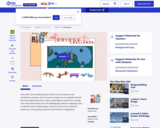
This excerpt from WGBH's Evening Compass news program summarizes events of the first year of the 1974 Boston school desegregation plan. [3:33]
- Subject:
- Social Studies
- Material Type:
- Audio/Video
- Provider:
- PBS LearningMedia
- Date Added:
- 12/01/2022

This excerpt from WGBH's Evening Compass news program summarizes events of the first year of the 1974 Boston school desegregation plan. [3:33]

The (Boston Public Schools) Capstone Project is an opportunity for students to engage in rigorous project-based learning. It is an opportunity for our students to develop skills to be life, career, and college-ready in a culturally affirming, developmentally structured academic project. To support this learning, Boston Public Schools Library Services, through the Massachusetts Library System, offer students high-quality, licensed digital resources.

See how plants make the world better (and the career lab a little bit happier) as you learn about rewarding careers in plant science.

In this Kindergarten through 2nd grade interactive video, students act out animal movements for a short brain break. [5:28]

In this 3rd through 5th grade brain break video, students act out different movements, using their psychomotor skills, found in sports. [5:56]

In this video from the Teaching Channel, 6th grade science teacher Channa Comer introduces her students to the engineering design process. Using eggs as model heads, students design and test football helmets to prevent injury to the "brains." Students then apply their neuroscience knowledge to the design process by analyzing the "injuries" and what the real-life medical outcomes would be. [9:43]

Find out how serious head concussions can be in this video segment adapted from NOVA scienceNOW.

This video segment from The Human Spark observes the brains responses to a series of cognitive tests.

This lesson, based on the 11-minute animated story "Brand New Flag" from the PBS KIDS series MOLLY OF DENALI, helps children use captions to access and convey meaning in informational texts. After Molly learns about the history of Alaska's state flag, she holds a contest to design a flag for the Trading Post. Entries come flooding in with captions to explain each design. Molly must decide which one truly captures the spirit of the Trading Post. After watching, students create informational text with captions in the context of a current unit that they are studying.

Molly does a school report on Benny Benson, a young Alaska Native boy who won a contest to design the Alaska state flag, and is inspired to hold a contest of her own, in this 11-minute animated story [25:25] from the PBS KIDS series MOLLY OF DENALI. Everyone is eager to have their flag chosen as the winner, but Molly must decide which one truly represents the Trading Post and the people of Qyah.

In this demonstration of chemical change, the presenter blows breath into a methylene blue solution releasing carbon dioxide which acidifies the water and changes it from a bright blue color to green.

Join us to learn about different breathing and stretching techniques. Following along with their instructor, children take ocean breaths and move their arms in various motions to follow along with their breath in order to calm and center themselves. [3:47]

This interactive activity, from the Web site developed for the PBS series "Building Big," use your knowledge of bridge design to match the right bridge location in a fictitious city.

In this interactive activity from the Building Big Web site, use your knowledge of bridge design to match the right bridge to the right location in a fictitious city.

See how a place-based high school curriculum project promotes STEM learning through local ethnography and conservation projects. This video segment showcases one of 11 CREST projects taking place in rural, coastal Maine communities. [5:40]

In this transcript of an interview for Eyes on the Prize, Harry and Eliza Briggs describe their experience in the first school desegregation case, Briggs v. Elliott.

Learn how educators across West Virginia are addressing issues of student attendance and literacy skills through these showcase programs.

Engage K-12 students with phenomena and science practices using this collection of supplementary digital media resources created by GBH in collaboration with NASA. The resources align with key NGSS Earth, space, and physical science disciplinary core ideas. To ensure that science content is accessible for all students, supports are included for students with disabilities or who are English learners; many resources have Spanish translations.

WGBH in collaboration with NASA presents digital media resources you can use to teach topics in K-12 Earth and Space Science. These free resources are organized into four grade bands. Each resource emphasizes engaging students in phenomena related to core ideas and science and engineering practices of the Next Generation Science Standards. Each topical collection includes a lesson plan and supplementary resources that feature a range of innovative media. Flexible support materials aid instructional use and integration into the classroom.

Teach language, vocabulary and listening comprehension with Celebrity Vocab clips! [1:31]